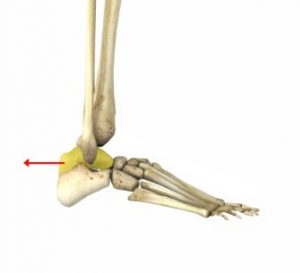Ankle Dorsiflexion:
If you are a sports medicine professional and looking for the best way to increase mobility and range of motion, joint mobs should be your technique of choice. Possessing good manual skills are part of what makes a good athletic trainer or physical therapist. Joint mobs are extremely beneficial, but also difficult to perform and take a lot of training and good, hands-on experience to perform correctly. Keep in mind that if they are not done correctly, they can actually do more damage than good. Because of this, the type, degree of movement and methods of joint mobs used by clinicians is regulated by state licensure acts and varies by state.
Due to all of the factors listed above, specific techniques won’t be discussed in detail. Rather, we will only present the basic concepts of what you are trying to accomplish to increase ankle dorsiflexion and some basic suggestions for general joint mob techniques. This is not intended to teach any specific techniques and we encourage you to seek more intense and hands on training. If you are interested in working with MTS to learn more about hands on manual therapy skills use the contact us page here.
Joint Mobilization Basics
A joint mobilization is a technique used to move a joint in a targetted manner to stress a specific portion of the joint (i.e. joint capsule, scar tissue, adhesions, etc.) to improve joint range of motion. This is usually done by stabilizing the areas above and below the joint to isolate the movement that you are working on.
Once the body parts around the joint are stabilized, you want to stress the joint to the end of it’s range of motion and then perform small, controlled oscillations. These oscillations are meant to stress the targetted tissue, promote joint movement by repetitively sliding the bones of the joint accross each other’s surface, and break up any adhesions that may exist.
A good oscillation will apply enough pressure that it is typically not very comfortable and may be slightly painful, but not so intense that the athlete is writhing in pain. The oscillations will help make the mobilization tolerable for the patient by repetitively loading and unloading the tissue.
The goal of a joint mob which is trying to increase ankle dorsiflexion is to decrease the amount of adhesions which may form following an injury and to stretch the posterior joint capsule around the ankle. The posterior capsule becomes tight with following an injury, as most athletes avoid dorsiflexion following an ankle sprain due to the amount of fluid that accumulates within the joint. We have also discussed the effects of the newest generation of athletic running shoes on the ankle joint due to the heel wedge which is built into them. Because of this daily repetitive plantar flexion, the posterior capsule is bound to tighten up.
It is also not all that rare to see an athlete with a partially dislocated talus who are very active. An athlete in this situation will present with a definite dorsiflexion restriction and a small palpable bump on the front of the ankle (you are feeling the anterior aspect of the talus).
Keys to Training
The easiest way to increase this motion is by performing a posterior glide with the Talus. This is performed by pushing the Talus posteriorly within the mortise joint of the ankle. This will obviously stress the posterior capsule of the ankle joint and decrease the adhesions and scar tissue that may be present.
This is easily done by placing your athlete in a few degrees of knee flexion to use their lower leg as a stabilization point on the end of the table. One hand will stabilize the proximal tibia, while the other had is placed around the front of the ankle joint and pushes posterior on the talus in an oscillating manner.
Other areas to address
You also may need to address ankle eversion and mid foot mobility to increase ankle dorsiflexion. If an athlete is tight and immobile in both of these areas and planes, they will never reach the full potential of their ankle dorsiflexion.
Looking for more help? Schedule a consultation today!
Back to Dorsiflexion Solutions
Back to Ankle Dorsiflexion
Back to Injury Rehabilitation
Back to Home



Leave a Reply